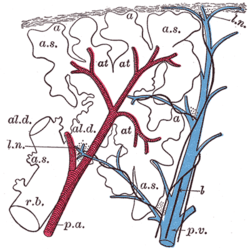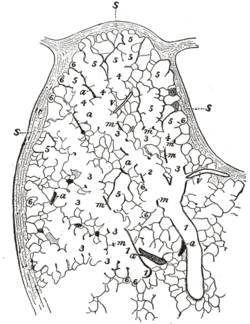Alveolar duct
| Alveolar duct | |
|---|---|
 Detailed drawing of the alveoli from Gray's Anatomy, 1918 - Schematic longitudinal section of a primary lobule of the lung (anatomical unit); r. b respiratory bronchiole; al. d alveolar duct; at atria; a. s alveolar sac; 'a' alveolus or air cell; p. a.: pulmonary artery; p. v pulmonary vein; l lymphatic; l. n lymph node. | |
 Part of a secondary lobule from the depth of a human lung, showing parts of several primary lobules. 1, bronchiole; 2, respiratory bronchiole; 3, alveolar duct; 4, atria; 5, alveolar sac; 6, alveolus or air cell: m, smooth muscle; a, branch pulmonary artery; v, branch pulmonary vein; s, septum between secondary lobules. | |
| Details | |
| Identifiers | |
| Latin | Ductus alveolaris |
| Code | TH H3.05.02.0.00022 |
Alveolar ducts are tiny ducts that connect the respiratory bronchioles to alveolar sacs, each of which contains a collection of alveoli (small mucus-lined pouches made of flattened epithelial cells). They are tiny end ducts of the branching airways that fill the lungs. Each lung holds approximately 1.5 to 2 million of them. The tubules divide into two or three alveolar sacs at the distal end. They are formed from the confluence openings of several alveoli. Distal terminations of alveolar ducts are atria which then end in alveolar sacs.
In human anatomy, respiratory bronchioles exist proximal to the alveolar ducts. The epithelial lining consists of smooth muscle knobs covered by nonciliated, simple cuboidal cells. The smooth muscle constricts under parasympathetic innervation and relax under sympathetic innervation.
Additional images
-
human alveolar duct
-

Bronchi, bronchial tree, and lungs
External links
- Anatomy Atlases - Microscopic Anatomy, plate 11.229 - "Alviolar Duct and Alveolar Sacs"
- Histology image: 13607loa – Histology Learning System at Boston University - "Respiratory System: lung (sheep), alveolar duct "
- Anatomy photo: respiratory/lung/lung7/lung3 - Comparative Organology at University of California, Davis - "Mammal, lung (EM, Medium)"